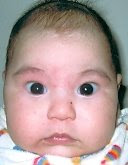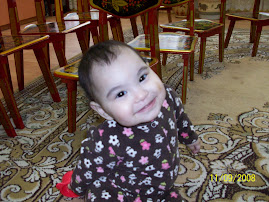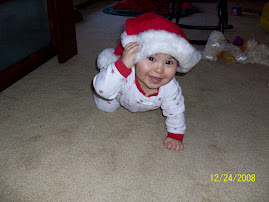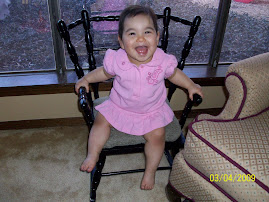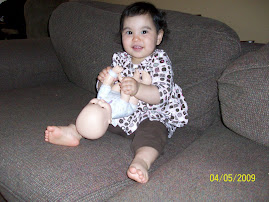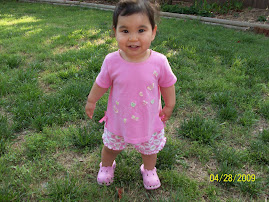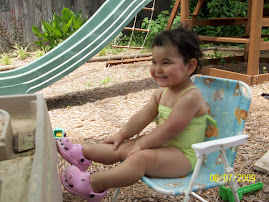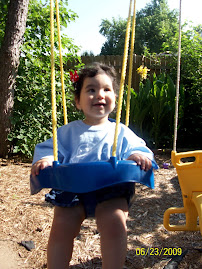I thought for those of you who are not adopting or for those who have not yet made the trip to Moscow, it would be interesting to post some facts about Moscow. Here is some general information according the Wikipedia:
Moscow In General:Moscow (
Russian: Москва́,
romanised: Moskvá,
IPA: (Click on the following for a pronunciation)
[mɐˈskva] is the
capital and the largest
city of
Russia, and the
largest city in Europe, with its metropolitan area ranking among the largest urban areas in the world. Moscow is the country's political, economic, religious, financial, educational and transportation center. It is located on the
Moskva River in the
Central Federal District, in the
European part of Russia. Historically, it was the capital of the former
Soviet Union and the
Grand Duchy of Moscow, the pre-
Imperial Russian state. It is the site of the
Moscow Kremlin, which serves as the ceremonial residence of the
President of Russia. Moscow is a major economic center and is home to the largest number of
billionaires in the world; in 2007 Moscow was named the
world's most expensive city for the second year in a row. It is home to many scientific and educational institutions, as well as numerous sport facilities. It possesses a complex transport system that includes the world’s busiest
metro system, which is famous for its architecture and artwork.
A Tornado? Toto, we aren't in Kansas any more!
Moscow has a hemiboreal climate (
Koppen climate classification Dfb) with warm, somewhat humid summers and long, cold winters. Typical high temperatures in the warm months of June, July and August are around 22
°C (72
°F); in the winter, temperatures normally drop to approximately -12
°C (10
°F). The highest temperature ever recorded was 36.7 °C (98.1 °F) in August 1998, and the lowest ever recorded was -42.2 °C in January 1940.
Monthly rainfall totals vary minimally throughout the year, although the
precipitation levels tend to be higher during the summer than during the winter. Due to the significant variation in temperature between the winter and summer months as well as the limited fluctuation in precipitation levels during the summer, Moscow is considered to be within a
continental climate zone.
The June 29, 1904 Moscow tornado was one of only two disastrous
tornadoes that occurred in central
Russia in recorded history (
the other occurred
June 9,
1984 in
Ivanovo and
Yaroslavl regions). The 1904 disaster started as a thunderstorm in
Tula region. It travelled northward, passing through eastern suburbs of
Moscow into Yaroslavl region. When the cloud approached remote Moscow suburbs, it formed a tornado funnel, destroying suburban settlements and
Lefortovo district within the city itself.
This explains why people park anywhere, including the sidewalk:
There are over 2.6 million cars in the city on a daily basis. Recent years have seen the growth in the number of cars, which have caused traffic jams and the lack of parking space to become major problems.
The
MKAD, along with the
Third Transport Ring and the future Fourth Transport Ring, is one of only three
freeways that run within Moscow city limits. However, as one can easily observe from a map of Moscow area, there are several other roadway systems that form
concentric circles around the city.
World's Most Expensive City (an example: Marriott Courtyard, per night is $450!)In 2006,
Mercer Management Consulting named Moscow the world's
most expensive city for expatriate employees, ahead of perennial winner
Tokyo, due to the stable
Russian ruble as well as increasing housing prices within the city.
A significant portion of Russia's profits and development is concentrated in Moscow as many multi-national corporations have branches and offices in the city. The plush offices and the lifestyles of the typical corporate employee in Moscow are often indistinguishable from any
Western European city, although the average salary for the Muscovite is a bit lower. Since the
Russian financial crisis in late 1998, various business sectors in Moscow have shown exponential rates of growth. Many new business centres and office buildings have been built in recent years, but Moscow still experiences shortages in office space. As a result, many former industrial and research facilities are being reconstructed to become suitable for office use.
Billionaires A Plenty:Moscow now has 74 billionaires with average wealth of $5.9 billion, placing it above New York, Forbes Magazine said in its annual rich list published on Thursday. According to the list, New York has 71 billionaires, followed by London with 36, Istanbul with 34, and Hong Kong with 30. Russia is second only to the United States in the number of its super-rich. An additional 35 Russians have crossed the $1 billion mark in the past year, helped along by the continued rise of the ruble against the dollar. "Sixteen years after the collapse of the Soviet Union, Russia, with 87 billionaires, is the new No. 2 country behind the U.S., easily overtaking Germany, with 59 billionaires, which held the honour for six years," said Forbes associate editor Luisa Kroll. The Unites States accounts for 469 (42 percent) of the world's billionaires. Topping the list of Russia's billionaires is Oleg Deripaska with $28 billion, placing him ninth in the world, ahead of the more famous Roman Abramovich with $23.5 billion, in 15th place. Deripaska's holding company, Basic Element, owns huge assets in insurance, auto manufacture, and aluminum, while Abramovich, since selling his oil company Sibneft to Russian state-controlled gas giant Gazprom in 2005, has bought up steel and mining assets. He also owns Chelsea Football Club. Russia's richest woman remains Elena Baturina, the 45-year-old second wife of Moscow Mayor Yuri Luzhkov. Forbes estimates that she has added $1.1 billion to her personal wealth in the past year, bringing it up to $4.2 billion and putting her in 253rd place globally.
Living Quarters:During
Soviet times, apartments were lent to people by the government according to the square meters-per-person norm (some groups, including people's artists, heroes and prominent scientists had bonuses according to their honours).
Private ownership of apartments was limited until the 1990s, when people were permitted to secure property rights to the places they inhabited. Since the Soviet era, estate owners have had to pay the service charge for their residences, a fixed amount based on persons per living area. Due to the current economic situation, the price of
real estate in Moscow continues to rise. Today, one could expect to pay US$4000 in average per square meter (11 sq ft) in the outskirts of the city or US$6000-$7000 per square meter in a prestigious district. The price sometimes may exceed US$40000 per square meter in a flat. It costs about US$2500 per month to rent a 1-bedroom apartment and about US$1500 per month for a studio in the center of Moscow.
A typical one-bedroom apartment is about thirty square meters (323 sq ft), a typical two-bedroom apartment is forty-five square meters (485 sq ft), and a typical three-bedroom apartment is seventy square meters (753 sq ft). Many cannot move out of their apartments, especially if a family lives in a two-room apartment originally granted by the state during the Soviet era. Some city residents have attempted to cope with the cost of living by renting their apartments while staying in
dachas (country houses) outside the city.
The Moscow Melting Pot:The
2002 Census reported the national composition as:
Russian 84.83%
Ukrainian 2.44%
Tatar 1.60%
Armenian 1.2%
Azeri 0.92%
Jews 0.67%
Belarusian 0.57%
Georgian 0.52%
Moldovan 0.35%
Tajik 0.34%
Uzbek 0.23%
Mordvin 0.22%
Chuvash 0.16%
Vietnamese 0.15%
Chechen 0.14%
Chinese 0.12%
Ossetian 0.10%
Korean 0.08%
Kazakh 0.08%
Pushtu 0.06%
Bashkir 0.06%
German 0.05%
Avar 0.05%
Polish 0.04%
many other groups of less than five thousand persons each.
Just over 4% of the inhabitants declined to state their ethnicity on the census questionnaire
The History of the Orphanage in Moscow:The Moscow Orphanage or Foundling Home (
Russian: Воспитательный дом в Москве) was an ambitious project conceived by
Catherine the Great and
Ivan Betskoy, in the early 1760s. This idealistic experiment of the
Age of Enlightenment was intended to manufacture "ideal citizens" for the Russian state by bringing up thousands of abandoned children to a very high standard of refinement, cultivation, and professional qualifications. Despite more than adequate staffing and financing, the Orphanage was plagued by high infant mortality and ultimately failed as a social institution.
The main building, one of the earliest and largest Neoclassical structures in the city, occupies a large portion of
Moskvoretskaya Embankment between
the Kremlin and
Yauza River, boasting a 379-metre frontage on
Moskva River. The complex was built in three stages over two centuries, from
Karl Blank's master plan (1767) to its complete implementation in the 1940s. Today, the ensemble of the Orphanage houses the
Academy of Missile Forces and
Russian Academy of Medicine.
Things are actually better now in Moscow Orphanages than they used to be:On the inauguration day, 19 newborn babies were brought to the unfinished Orphanage. Two of them were publicly
baptized Catherine and Paul, after the Empress and her heir, but both died soon afterward. This was an early portent of extremely high infant mortality that would be characteristic of the Orphanage in the 18th century.
Of some 40,996 children admitted to the Orphanage during Catherine II's reign, 35,309, or 87%, died during their stay there. As a result, the vast complex housed only a handful of survivors. A 1792 report listed as few as 257 resident orphans who studied a variety of trades ranging from metallurgy to accountancy. Several attempts to decrease mortality by passing infants on to
foster families did not improve the survival rate. The aged Betskoy could not be relied on for managing the expanding faculty, and the Orphanage became notorious for fraud and child abuse.
Children lived at the Orphanage until the age of 11, whereupon they were sent for training to local factories and government offices. Some were assigned to the
Michael Maddox theater school; others managed to qualify for free admission to
Moscow State University. 180 students furthered their education in the universities of Western Europe. The majority, however, graduated with little more than a rouble in cash and a
passport (which served to distinguish free men from serfs).
The institution was managed by the Board of Trustees and financed by private donations and two special taxes - a tax on public theater shows and a tax on
playing cards. For nearly a century, all playing cards sold in Imperial Russia were taxed 5 kopecks per deck on domestic-made cards and 10 kopecks on imports. As a result, every pack of Russian cards displayed the symbol of the Orphanage, the
pelican. This tax generated 21,000 roubles in 1796 and 140,000 roubles by 1803.
Beginning in 1772, the Orphanage also managed three
banks: Loan Treasury, Savings Treasury, and Widows Treasury. These financial institutions, initially plagued by fraud and poor management, became effective and influential under the guidance of
Empress Maria. By 1828, their total assets exceeded 359 million roubles, the largest capital assets in all of Moscow. This stock was the principal source of cash for the Orphanage throughout the 19th century.
Today's Orphanages in Moscow:
Orphanages, per say, do not exist in the U.S. because we have a foster care system, with the ultimate goal being to reunite families with their children, for better or worse. Russia is currently trying to install a foster care system. As I understand it, while in foster care, the children are not available for adoption. The family taking them in receives money and keeps them for a couple of years. After that, many may be returned to orphanages. It's interesting that there are 39 orphanages in Moscow alone (of which 23 are baby orphanages ) and 74 billionaires in the same city. It's sad that there can be so many with so little living in the same city as so many with so much.
U.S. kids exiting the foster care system will, most likely, go on to lead productive lives, having grown up in family environments. Russian orphans do not fair so well. When they exit the system at age 16-18, 90% will go on to become prostitutes/drug addicts. And people ask us, "Why Russia?" That's one reason.











 Next, Katia and her bear rode in the car in a dossier appropriate carseat to the airport:
Next, Katia and her bear rode in the car in a dossier appropriate carseat to the airport:
 And, lastly, Katia napping in the Moscow City awaiting transport to the agency. She needs her beauty rest after all:
And, lastly, Katia napping in the Moscow City awaiting transport to the agency. She needs her beauty rest after all: Now, we are waiting to hear about a referral!!! Katia, pick out a great baby for us, dear! Stay tuned for updates...
Now, we are waiting to hear about a referral!!! Katia, pick out a great baby for us, dear! Stay tuned for updates...

